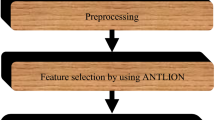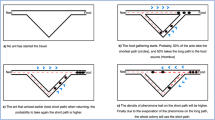Abstract
Asthma has become the serious chronic and the most common disease of hospitalization in children. Recently, the number of children with asthma has increased year by year. Thereafter, the medical community pays much attention to the treatment of asthma. Because of noises or outlier, the resulting factors for asthma are complex. Traditional algorithms usually assume that asthma data are evenly distributed among various classes and might ignore minority classes. Therefore, an intelligent algorithm based on bacterial foraging optimization (BFO) and robust fuzzy algorithm (RFA) is applied to analyze asthma data in this paper. In the proposed algorithm, RFA with the property of robust can reduce the influence of noises or outlier. It can establish the fuzzy model and effectively analyze asthma data. For foraging theory, natural selection trends to eliminate animals with poor foraging strategies and to favor the propagation of genes for animals which have successful foraging strategies. BFO can model the mechanism of natural selection and find the best solution. Consequently, it can enhance the classification accuracy of asthma data. In this paper, asthma data were collected from Mackay Memorial Hospital in Taiwan to test the performance of the proposed algorithm. The performance of the proposed algorithm is supported by simulation results. From simulation results, the classification accuracy of the proposed algorithm outperforms other existing approaches and can help physicians to determine asthma.



Similar content being viewed by others
References
DCAsthma: http://www.dcasthma.org/index.htm
GINA: http://www.ginasthma.com
Hardy, S.G.: Nursing implications of increasing asthma prevalence. Br. J. Nurs. 1(13), 653–659 (1992)
Hanifi, G., Abdulkadir, S.: Comparison of clustering algorithms for analog modulation classification. Expert Syst. Appl. 30, 642–649 (2006)
Hannu, T.T., Päivi, O., Kari, V., Vesa, O., Petteri, S., Heikki, M., Mathias, H., Juha, K.: Data mining applied to linkage disequilibrium mapping. Am. J. Human Genet. 67(1), 133–145 (2000)
Manfred, H., David, M., Charles, M.G., Louisa, W., Eugene, P.: The role of data mining in pharmacovigilance. Expert Opin. Drug Saf. 4(5), 929–948 (2005)
Shiur, I.S.: Classifying asthma by hybrid intelligent algorithms. Master thesis, Huafan University Taiwan (2010)
Chawla, N.V., Japkowicz, N., Kotcz, A.: Proceedings of the ICML’2003 Workshop on Learning from Imbalanced Data Sets (2003)
Japkowicz, N.: Proceedings of the AAAI’2000 Workshop on Learning from Imbalanced Data Sets (2000)
Lee, C.Y., Lee, Z.J.: A novel algorithm applied to classify unbalanced data. Appl. Soft Comput. 12(8), 2481–2485 (2012)
Tao, Q., Wu, G.W., Wang, F.Y., Wang, J.: Posterior probability support vector Machines for unbalanced data. IEEE Trans. Neural Netw. 16, 1561–1573 (2005)
Fu, X., Wang, L., Chua, K.S., Chu, F.: Training RBF neural networks on unbalanced data. In: Proceedings of the 9th International Conference on Neural Information Processing, vol. 2, pp. 1016–1020 (2002)
Searle, S.R.: Linear models for unbalanced data. Wiley, New York (1987)
Hogg, R.V., Ledolter, J.: Engineer statistics. MacMillan Publishing Company, England (1987)
Lu, Y., Guo, H., Feldkamp, L.: Robust neural learning from unbalanced data samples. In: The 1998 IEEE International Joint Conference on Neural Networks, vol. 3, pp. 1816–1821 (1998)
Wang, J., Jean, J.: Resolve Multifont character confusion with neural network. Pattern Recogn. 26, 173–187 (1993)
Lee, Z.J.: An integrated algorithm for gene selection and classification applied to microarray data of ovarian cancer. Int. J. Artif. Intell. Med. 42, 81–93 (2008)
Wang, J., Miyazaki, M., Kameda, H., Li, J.: Improving performance of parallel transaction processing systems by balancing data load on line. In: Seventh International Conference on Parallel and Distributed Systems, vol. 5, pp. 331–338 (2000)
Weiss, S., Indurkhya, N.: Rule-based machine learning methods for functional prediction. J. Artif. Intell. Res. 3, 383–403 (1995)
Yang, X., Song, Q., Cao, A.: Clustering nonlinearly separable and unbalanced data set. In: 2004 2nd International IEEE Conference on Intelligent Systems, vol. 2, pp. 491–496 (2004)
Ye, D., Chen, Z. (2008) A rough set based minority class oriented learning algorithm for highly unbalanced data sets. In: IEEE International Conference on Granular Computing, pp. 736–739 (2008)
Zhang, J., Bloedorn, E., Rosen, L., Venese, D.: Learning rules from highly unbalanced data sets. In: Fourth IEEE International Conference on Data Mining, ICDM ‘04, vol. 1–4, pp. 571–574 (2004)
Panigrahi, B.K., Pandi, V.R.: Congestion management using adaptive bacterial foraging algorithm. Energy Convers. Manag. 50, 1202–1209 (2009)
Passino, K.M.: Distributed optimization and control using only a germ of intelligence. In: Proceedings of the 2000 IEEE International Symposium on Intelligent Control (2000)
Passino, K.M.: Biomimicry of bacterial foraging for distributed optimization and control. IEEE Control Syst. Mag. 22, 52–67 (2002)
Zhang, Y., Wu, L.: Stock market prediction of S&P 500 via combination of improved BCO approach and BP neural network. Expert Syst. Appl. 36, 8849–8854 (2009)
Niu, B., et al.: Multi-objective bacterial foraging optimization. Neurocomputing 116, 336–345 (2013)
Ghoshal, S.P., Chatterjee, A., Mukherjee, V.: Bio-inspired fuzzy logic based tuning of power system stabilizer. Expert Syst. Appl. 36, 9281–9292 (2009)
Hazra, J., Sinha, A.K.: Environmental constrained economic dispatch using bacteria foraging optimization. In: Joint International Conference on Power System Technology and IEEE Power India Conference, pp. 1–6 (2008)
Lee, U., Magistretti, E., Gerla, M., Bellavista, P., Lió, P., Lee, K.W.: Bio-inspired multi-agent data harvesting in a proactive urban monitoring environment. Ad Hoc Netw. 7, 725–741 (2009)
Tripathy, M., Mishra, S.: Bacteria foraging-based solution to optimize both real power loss and voltage stability limit. IEEE Trans. Power Syst. 22, 240–248 (2007)
Salzberg, S.L.: On comparing classifiers: pitfalls to avoid and a recommended approach. Data Min. Knowl. Discov. 1, 317–327 (1997)
Jiang, Y., Zhou, Z.H.: Training data for kNN classifiers with neural network ensemble. ISNN 1, 1–6 (2004)
Zhang, J., Mani, I.: kNN approach to unbalanced data distributions: A case study involving information extraction. In: Proceedings of the ICML’2003 Workshop on Learning from Imbalanced Datasets (2003)
Lee, Z.J., Chang, L.Y.: Apply fuzzy decision tree to information security risk assessment. Int. J. Fuzzy Syst. 16(2), 265–269 (2014)
Vapnik, V.N.: Statistical learning theory. Wiley, New York (1998)
Burges, C.J.: A tutorial on support vector machines for pattern recognition. Data Min. Knowl. Disc. 2(2), 121–167 (1998)
Lezoray, O., Cardot, H.: A neural network architecture for data classification. Int. J. Neural Syst. 11(01), 33–42 (2001)
Srikanth, R., et al.: A variable-length genetic algorithm for clustering and classification. Pattern Recogn. Lett. 16(8), 789–800 (1995)
Fawcett, T.: An introduction to ROC analysis. Pattern Recogn. Lett. 27, 861–874 (2006)
Blake, C., Keogh, E., Merz, C.J.: UCI repository of machine learning databases. http://www.ics.uci.edu/»mlearn/MLRepository.html (1998), Department of Information and Computer Science, University of California, Irvine, CA
Acknowledgement
The authors would like to thank the Ministry of Science and Technology of the Republic of China, Taiwan, for financially supporting this research under Contract Nos. MOST 105-2632-M-211-001 and MOST 104-2221-E-211-008.
Author information
Authors and Affiliations
Corresponding author
Rights and permissions
About this article
Cite this article
Yang, MR., Lee, ZJ., Lee, CY. et al. An Intelligent Algorithm Based on Bacteria Foraging Optimization and Robust Fuzzy Algorithm to Analyze Asthma Data. Int. J. Fuzzy Syst. 19, 1181–1189 (2017). https://doi.org/10.1007/s40815-017-0294-1
Received:
Revised:
Accepted:
Published:
Issue Date:
DOI: https://doi.org/10.1007/s40815-017-0294-1




